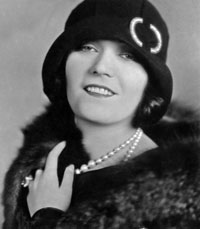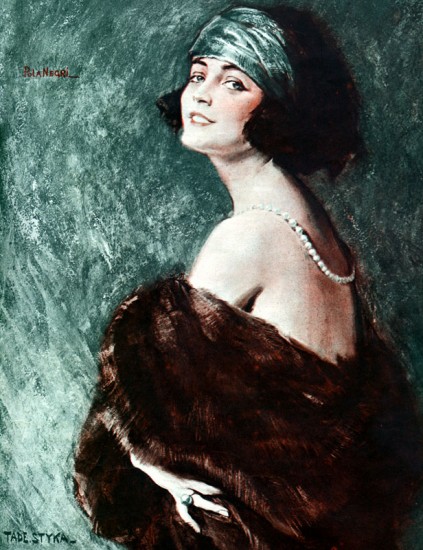
 |
Pola Negri was born as Barbara Apolonia Chałupiec on 3 January 1897 in the small town of Lipno in Poland and died on 1 August 1987 in San Antonio, USA. She was a movie star, a legend and a world-famous actress. Her exotic looks, charisma, rich facial expressions and pantomimic skills made her film appearances well remembered by the audience for whom she became a screen goddess. She created femme fatale characters and became a symbol of the era followed by the period of rapid development of cinema. She gained real star status and went down in cinema history as the first European and in fact the only Polish actress who genuinely made it big in Hollywood.
Pola Negri began her career in Poland, appearing in films during the pioneering period of Polish cinema. This is when she joined the “Sfinks” film studio run by Aleksander Hertz, a film producer who made e.g. “Beast” (1917), and gained herself a good reputation as an exceptionally gifted actress. She parted company with them after she received an invitation to Berlin coming from Max Reinhardt, a legend in the world of German theatre who wanted her to appear in his stage play “Sumurun”. She truly enjoyed playing regularly in films by Ernst Lubitsch, recognised as the grand master of cinema. Under his guidance, she developed her acting technique and reached the height of her popularity. During her stay in Berlin she appeared in a number of films that proved important for her career, including “Mania” (1918), “Carmen” (1918), “Madame Dubarry” (1919) and a movie version of “Sumurun” (1920).
Rumours of her talent attracted the attention of America's movie moguls and in 1923 Pola Negri was brought in triumph to Hollywood. While in America, she modified her image to become rather chic but still remained the object of lust. The most famous movie stars were attracted to her. She had a romantic affair with Charlie Chaplin, was engaged to Rudolph Valentino and became a duchess upon her marriage to Sergiusz Mdivani from Georgia. She played the roles of exotic dancers in “Men” (1924) and “The Spanish Dancer” (1923) or underworld girls e.g. in “Shadows of Paris” (1924). Among her performances was the title role of Catherine the Great in “Forbidden Paradise” (1924) directed by Lubitsch. She also appeared in a number of comedy films where she displayed her comic skills, including “A Woman of the World” (1925) and “Good and Naughty” (1926). She created an unforgettable role in “Hotel Imperial” (1927) by Mauritz Stiller, the master of Swedish cinema.
 |
With the arrival of sound, Hollywood lost interest in its early movie stars. Admittedly, Pola Negri passed voice testing and even started to record the songs she sang in her movies, but her expressive acting style was becoming obsolete. The actress returned to Europe where a German producer offered her a role in “Mazurka” (1935) directed by Willi Forst. She found it difficult to work in Hitler’s Germany but she nevertheless played two important roles at that time in “Moscow- Shanghai” (1936) and “Tango Notturno” (1937). On the eve of the Second World War she managed to leave Germany and after nearly one-and-a-half year stay in France she emigrated to the United States of America. After several years she made an appearance in a comedy film “Hi Diddle Diddle” (1943) and the last time she was seen on the big screen was in 1964 when she played the role of Madame Habib in “The Mood Spinners” (1964). She was considered a silent film legend until the end of her life. She appeared in more than sixty movies, she developed a unique acting style that combined the skill of using facial expressions with dancing, she made friends with some of the most famous people of her time such as Albert Einstein, and the most romantic Hollywood actors fell head over heels in love with her. Her ‘Cinderella’ dream came true. She reached the height of success and fame in cinema and was remembered as the true queen of the screen. On many occasions she highlighted she felt a strong emotional attachment to Poland. She used to say, “I have never ceased to feel Polish and I have always been keen to emphasise my Polish roots.”
|
|
More about Pola Negri: in a biography published by “Prószyński i S-ka” entitled “Pola Negri: Legenda Hollywood” (Pola Negri: Holywood Legend) by Mariusz Kotowski (Warsaw 2011).
Mariusz Kotowski, a Polish-born film director, describes the extraordinary career path of the actress who won the hearts of not only the public but also male Hollywood celebrities with her film roles. The book has been enriched with a remarkable collection of photographs of Pola Negri, her on-screen partners and other people she met in her busy life.
Mariusz Kotowski’s book (Polish edition) as well as a special free multimedia publication about the book and the film, published by Prószyński i S-ka and Filmoteka Narodowa, will be available during the re-premiere of MANIA at Warsaw Philharmonic.

- WIOSNA NARCIARZY
- SZTANDAR WOLNOŚCI
- PIERWSZA MIŁOŚĆ KOŚCIUSZKI
- KOŚCIUSZKO POD RACŁAWICAMI
- HALKA
- Ludzie bez jutra
- Zew morza
- O filmie ZEW MORZA
- Konserwacja filmu
- Muzyka do filmu
- Wystawa wirtualna
- Partnerzy/patroni
- Zwiastun filmowy
- PAN TADEUSZ
- O filmie
- Warsztaty
- Partnerzy/patroni
- O rekonstrukcji PANA TADEUSZA
- Pracownicy Nitrofilmu o pracach nad filmem
- PAN TADEUSZ on-line
- Video-relacje
- Re-Premiere of the film “MANIA”
- About the film
- Reconstruction
- Pola Negri - superstar
- Music
- Exhibition
- Partners
- O re-premierach














